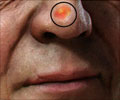- Boamah H, Knight G, Taylor J, Palka K, Ballard B. Squamous Cell Carcinoma of the External Auditory Canal: A Case Report. Case Reports in Otolaryngology Volume 2011 (2011), Article ID 615210, 4 pages - (http://dx.doi.org/10.1155/2011/615210)
- Manipal Manual of Surgery 4th edition
- Maneesh S G, Manjula. B. V, Arun B Nair, Balasubramanya. A.M. Adenoid cystic carcinoma of external auditory canal. The Internet Journal of Otorhinolaryngology. 2009 Volume 11 Number 2.
- Tos M. Manual of Middle Ear Surgery. Vol 3. Surgery of the External Auditory Canal.
What are Ear Cancers?
The human ear is made up of three parts – the outer ear, the middle ear, and the inner ear. The outer and the middle ear are separated by the tympanic membrane or the eardrum.
The middle ear contains the three small bones of the ear, the malleus, incus, and the stapes. The inner ear contains the hearing organ called the cochlea as well as the organ involved in balance, which is called the vestibule. The outer ear is lined by skin. The skin of the ear canal is lined by glands that secrete wax. The ear is located in the temporal bone, which comprise the bones on the sides of the skull.
Cancers that affect the ear are extremely rare. Skin cancers are the commonest form of cancers affecting the outer ear. Cancer can also arise from the glands lining the ear. Other rare forms of cancer include those that arise from the cartilage, the soft tissue, and the bone.
Types of Ear Cancers
Cancers of the ear include:
- Squamous cell cancer, which is the most common tumor of the external ear canal
- Basal cell cancer
- Melanoma
- Adenoid cystic carcinoma
- Ceruminous adenocarcinoma
- Soft tissue cancers like rhabdomyosarcoma and fibrosarcoma
- Cartilage and bone cancers like chondrosarcoma and osteosarcoma
Causes of Ear Cancers
The exact cause of ear cancer is not known. Chronic ear infections increase the chances of ear cancer. Skin cancers like basal cell cancer are common in skin that is exposed to ultraviolet rays and in white skin. Squamous cell cancers often arise due to chronic irritation.
Ear cancers may not only deform the ear, but they may also affect hearing. Early treatment with surgery and/or radiotherapy can often control the cancer. Regular follow-up is advised following initial treatment to rule out recurrence of the cancer.
Signs and Symptoms of Ear Cancers
The signs and symptoms of some of the more common forms of ear cancer are listed below:
Basal cell cancers are commonly found on the face and can affect the ear. They present as an ulcer with raised and beaded edges. The ulcer does not heal over a prolonged period of time. The base may feel hard and the ulcer may bleed when touched. A scab may be present. In some cases, the cancer can appear as a hard nodule. Aggressive basal cancers may deform the entire external ear. Unlike several other cancers, basal cell cancers usually do not spread to distant sites. They spread locally and destroy tissues.
Squamous cell cancers appear as cauliflower-like growths or as ulcers, or with features of both. The base is hard and the edges are everted. The ulcer bleeds easily when touched. The ulcer may be attached to the underlying tissue. Squamous cell cancers of the ear spread locally to lymph nodes and sometimes through blood. They may also spread to the underlying temporal bone.
Malignant melanomas usually arise from a pre-existing mole. The cancer appears as a brown-to-black lesion that quickly increases in size and has an irregular border. It may also appear as a pigmented ulcer. Malignant melanoma may spread to the surrounding tissues resulting in small satellite and skip lesions around the primary cancer. Malignant melanomas also spread through the blood and the lymphatics.

Adenoid cystic carcinomas are rare, slow growing cancers of the external auditory canal. They arise from the ceruminous glands that secrete wax, sweat glands, or the salivary gland tissue that may be inappropriately positioned in the ear. Symptoms include a sharp pain that radiates from the ear, hearing loss, tinnitus, and facial weakness. The cancer may appear as a swelling, polyp, or an ulcer. There may be discharge from the ear with pus and sometimes blood. The cancer may spread locally to the bone, the soft tissues, and the salivary glands, or may spread to the lymph nodes and even distant sites like the lung and the liver.
Ceruminous adenocarcinoma is another tumor involving the earwax-secreting glands that usually spreads locally. Other cancers affecting soft tissues, cartilage, and bone, show symptoms similar to those when they affect other areas of the body.
Diagnosis of Ear Cancers
The diagnosis of ear cancer is made based on:
- History of the patient, where the patient may report the presence of a fast-growing obvious growth, or may come to the doctor with symptoms of ear discharge or hearing problems.
- Physical examination, which may reveal the diagnosis to the physician. Hearing should also be tested.

- Biopsy of the lesion, which confirms the diagnosis. The biopsy of a malignant melanoma should include the entire lesion. A biopsy of only one part may result in the spread to deeper tissues.
- CT and MRI to identify deeper cancers and check for their spread.
Treatment for Ear Cancers
The treatment of ear cancer depends on the type of cancer, the stage of the cancer as it indicates the spread of the disease, and the exact location of the cancer in the ear.
Basal cell cancers are mainly treated with surgery and radiation. Surgery is preferred for cases affecting the ear. Plastic surgery may be required to surgically reconstruct the ear.
Squamous cell cancers are also treated with surgery or sometimes with radiation. It is necessary to treat any spread of the cancer as well.
Malignant melanomas, adenoid cystic carcinomas, and most other ear cancers are treated surgically.
Besides primary cancer, it is also necessary to treat the sites where the cancer has spread including the lymph nodes. A regular follow-up is necessary to ensure that the cancer does not recur or has spread to other parts of the body.
Prevention of Ear Cancers
Though ear cancers cannot always be prevented, here are some suggested ways that could reduce your chances of developing ear cancer:
- Since chronic ear infections may predispose an individual to cancer, any chronic ear infection should be treated.
- Excessive exposure to the sun should be avoided to avoid skin cancers. If unavoidable, a sunscreen that provides adequate protection may be used.
- White-skinned individuals should undergo regular check-ups for suspicious lesions since they are more prone to certain skin cancers.
- Any lesion that is hard, grows very fast, changes in character quickly, and does not heal easily should be investigated.








